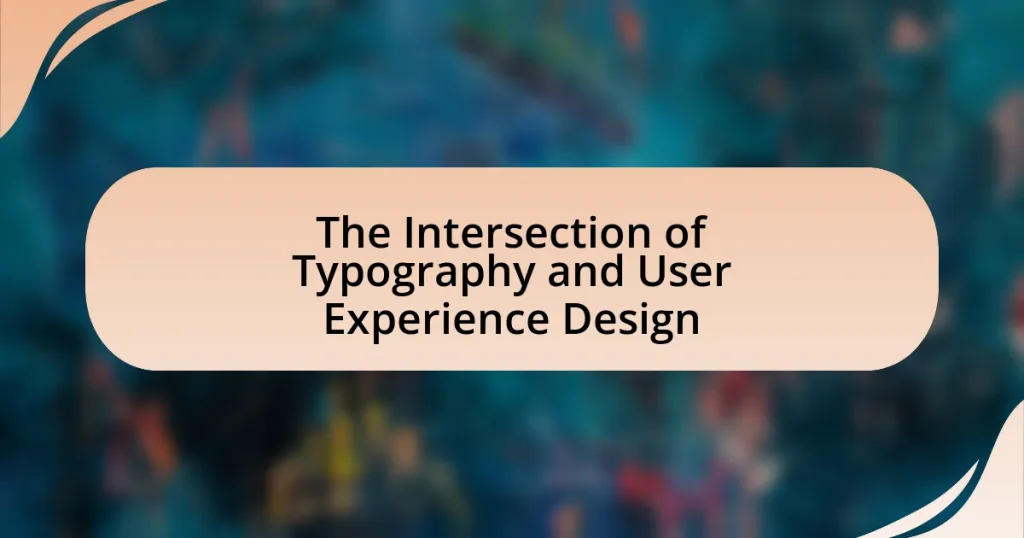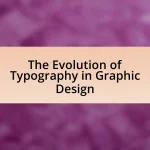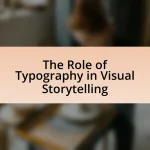The article explores the critical relationship between typography and user experience design, emphasizing how typography impacts readability, accessibility, and user engagement on digital platforms. It highlights that effective typography enhances clarity and guides users through information, with research indicating that 95% of users consider typography a key factor in their overall experience. The article discusses the principles of typography, including readability, hierarchy, consistency, and alignment, and examines how font choices influence user perception and emotional response. Additionally, it addresses the negative effects of poor typography on user experience and provides practical tips for optimizing typography in design.
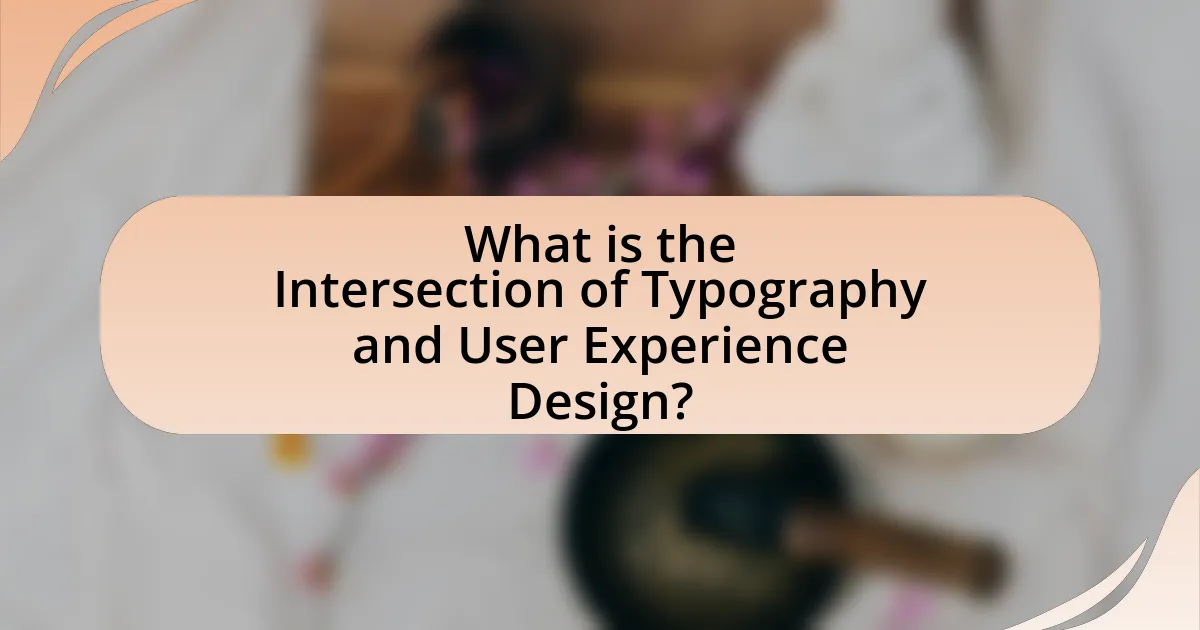
What is the Intersection of Typography and User Experience Design?
The intersection of typography and user experience design lies in how typography influences readability, accessibility, and overall user engagement on digital platforms. Typography affects the way users perceive and interact with content, as well-chosen fonts and layouts can enhance clarity and guide users through information effectively. Research indicates that 95% of users consider typography a key factor in their overall experience, highlighting its importance in design. Effective typography not only improves aesthetic appeal but also contributes to usability, ensuring that users can easily navigate and comprehend the information presented.
How do typography and user experience design relate to each other?
Typography and user experience design are closely related as typography significantly influences how users perceive and interact with content. Effective typography enhances readability, establishes visual hierarchy, and guides user attention, which are essential elements of a positive user experience. Research indicates that 95% of users consider typography a key factor in their overall impression of a website, highlighting its importance in user engagement and satisfaction. Thus, the relationship between typography and user experience design is foundational, as well-executed typography can lead to improved usability and a more enjoyable interaction with digital products.
What role does typography play in enhancing user experience?
Typography plays a crucial role in enhancing user experience by improving readability, establishing hierarchy, and conveying brand identity. Effective typography ensures that text is legible and accessible, which directly impacts how users interact with content. Research indicates that well-chosen fonts can increase comprehension by up to 20%, as users are more likely to engage with text that is easy to read. Additionally, typography helps create a visual hierarchy, guiding users through information in a logical manner, which can reduce cognitive load and improve navigation. Furthermore, consistent typography reinforces brand identity, making digital experiences more memorable and cohesive.
How can poor typography negatively impact user experience?
Poor typography can significantly hinder user experience by making content difficult to read and comprehend. When text is poorly spaced, misaligned, or uses inappropriate font choices, users may struggle to engage with the material, leading to frustration and increased cognitive load. Research indicates that readability is crucial for user retention; for instance, studies show that users are 25% more likely to abandon a website if they find the text hard to read. Additionally, inconsistent typography can create a disjointed visual hierarchy, causing users to miss important information or calls to action. This negative impact on usability ultimately diminishes user satisfaction and can result in lower conversion rates for businesses.
Why is typography important in user experience design?
Typography is important in user experience design because it directly influences readability, accessibility, and overall user engagement. Effective typography enhances the clarity of information, making it easier for users to process content quickly. Research indicates that well-chosen fonts can improve comprehension by up to 20%, as demonstrated in studies by the Nielsen Norman Group, which highlight the significance of legibility and visual hierarchy in digital interfaces. Additionally, typography contributes to brand identity, creating a cohesive experience that resonates with users and fosters trust.
What psychological effects does typography have on users?
Typography significantly influences users’ psychological responses by affecting readability, emotional perception, and brand identity. For instance, studies show that typeface choice can evoke specific emotions; serif fonts often convey tradition and reliability, while sans-serif fonts are perceived as modern and clean. Research by the University of Reading indicates that typography impacts comprehension and retention, with well-designed text leading to better user engagement and satisfaction. Furthermore, consistent typography reinforces brand identity, enhancing trust and recognition among users.
How does typography influence readability and comprehension?
Typography significantly influences readability and comprehension by affecting how easily text can be processed and understood. Factors such as font choice, size, spacing, and contrast play crucial roles in determining the clarity of written content. For instance, studies have shown that sans-serif fonts, like Arial and Helvetica, are generally easier to read on screens, while serif fonts, such as Times New Roman, are often preferred for printed materials due to their traditional appearance and readability in long texts. Additionally, proper line spacing and letter spacing enhance readability by preventing visual crowding, which can hinder comprehension. Research conducted by the International Journal of Human-Computer Studies indicates that optimal typography can improve reading speed by up to 20%, demonstrating its direct impact on user experience and information retention.
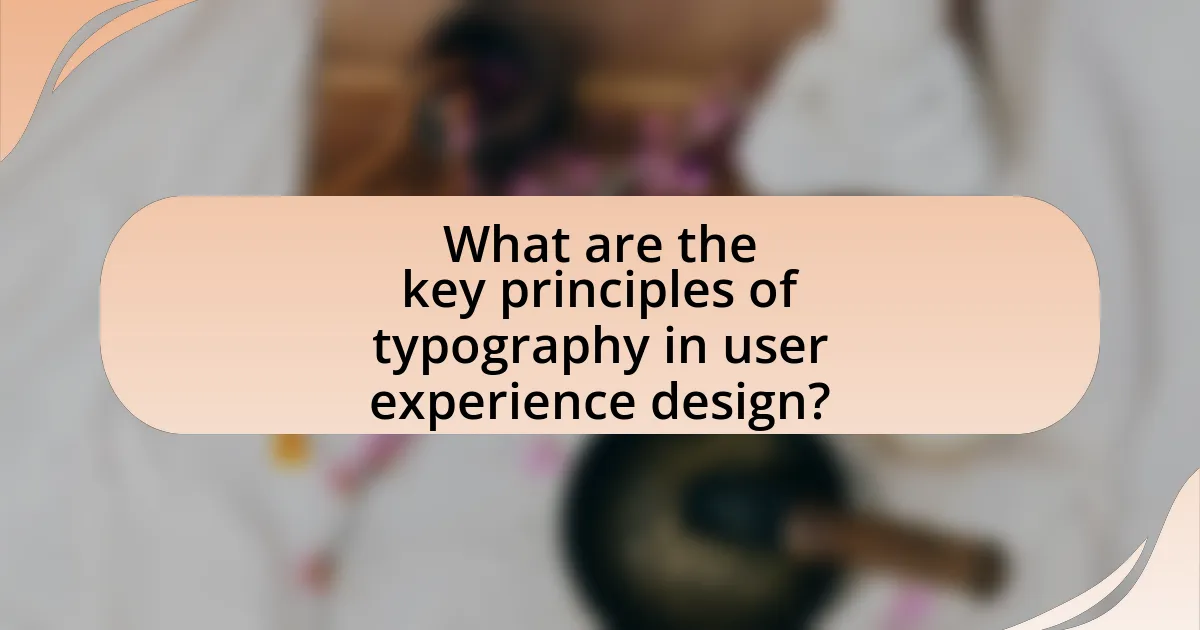
What are the key principles of typography in user experience design?
The key principles of typography in user experience design include readability, hierarchy, consistency, and alignment. Readability ensures that text is easy to read and comprehend, which is crucial for user engagement; studies show that well-chosen typefaces can improve reading speed by up to 20%. Hierarchy organizes content visually, guiding users through information in a logical order, often achieved through varying font sizes and weights. Consistency across different platforms and devices fosters familiarity and trust, as users can predict how text will appear. Alignment creates a clean layout, enhancing the overall aesthetic and usability of the design, as misaligned text can lead to confusion and distraction. These principles collectively enhance user experience by making content accessible and engaging.
How do font choices affect user perception?
Font choices significantly affect user perception by influencing readability, emotional response, and brand identity. Research indicates that different fonts evoke distinct feelings; for example, serif fonts often convey tradition and reliability, while sans-serif fonts are perceived as modern and clean. A study by the University of Reading found that typeface can impact the perceived credibility of information, with participants rating text in a serif font as more trustworthy than the same text in a sans-serif font. Additionally, the choice of font can enhance or detract from user engagement, as legible fonts improve comprehension and retention, ultimately shaping the overall user experience.
What factors should be considered when selecting fonts for a design?
When selecting fonts for a design, factors such as readability, brand alignment, and context of use must be considered. Readability ensures that the text is easily legible across various sizes and mediums, which is crucial for user experience; studies show that sans-serif fonts are often more readable on screens. Brand alignment involves choosing fonts that reflect the brand’s personality and values, as specific typefaces can evoke different emotions and associations. Context of use refers to the environment in which the design will be viewed, such as print versus digital, which can influence font choice due to varying display characteristics. These factors collectively contribute to effective communication and user engagement in design.
How do different font styles convey different messages?
Different font styles convey different messages by influencing perception and emotional response. For example, serif fonts, such as Times New Roman, are often associated with tradition and reliability, making them suitable for formal documents. In contrast, sans-serif fonts like Arial project modernity and simplicity, which can enhance readability in digital formats. Script fonts evoke elegance and creativity, often used in invitations or branding to convey a personal touch. Research indicates that font choice can significantly affect user engagement; a study by the University of Reading found that typeface can alter the perceived credibility of information. Thus, the selection of font style is crucial in user experience design, as it shapes how messages are interpreted and understood.
What is the significance of hierarchy in typography?
Hierarchy in typography is significant because it organizes content, guiding readers through information in a structured manner. This organization enhances readability and comprehension, allowing users to quickly identify key points and navigate text efficiently. Research indicates that effective typographic hierarchy can improve user engagement and retention, as seen in studies where well-structured text led to a 47% increase in information recall among participants. Thus, hierarchy not only aids in visual appeal but also plays a crucial role in user experience by facilitating better interaction with written content.
How can visual hierarchy guide user navigation?
Visual hierarchy guides user navigation by organizing content in a way that prioritizes information based on its importance, making it easier for users to find what they need. Effective use of size, color, contrast, and spacing directs attention to key elements, such as headings and calls to action, which enhances usability. Research indicates that users typically scan web pages in an F-pattern, where they focus on the top and left areas first; thus, placing critical information in these zones aligns with natural reading patterns and improves navigation efficiency.
What techniques can be used to establish effective typographic hierarchy?
To establish effective typographic hierarchy, designers can utilize techniques such as varying font sizes, weights, and styles to create visual distinctions among text elements. For instance, larger font sizes typically indicate primary headings, while smaller sizes can denote subheadings or body text, guiding the reader’s attention through the content. Additionally, using contrasting font weights, such as bold for headings and regular for body text, enhances readability and emphasizes important information. Furthermore, employing different typefaces can also contribute to hierarchy; for example, a serif font for headings paired with a sans-serif font for body text can create a clear visual separation. Research indicates that these techniques improve user comprehension and engagement, as effective hierarchy helps users navigate content more intuitively.
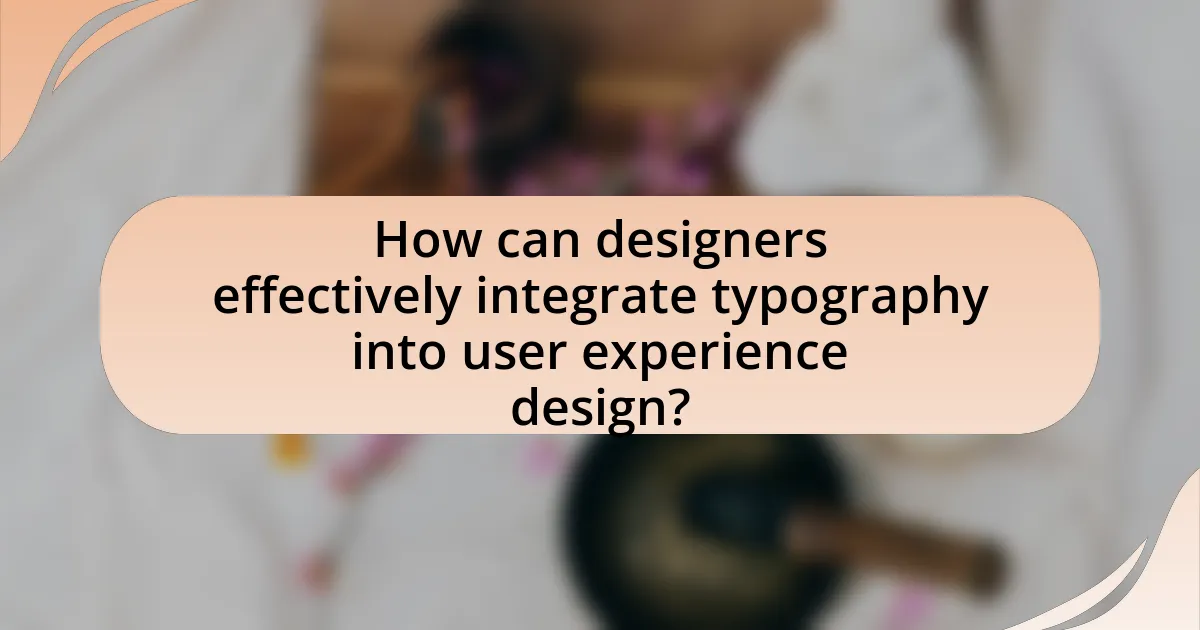
How can designers effectively integrate typography into user experience design?
Designers can effectively integrate typography into user experience design by ensuring that type choices enhance readability, establish hierarchy, and convey brand identity. Readability is crucial; studies show that well-chosen fonts can improve comprehension by up to 20%. Establishing a clear hierarchy through size, weight, and spacing helps users navigate content efficiently, as evidenced by research indicating that users scan pages in an F-pattern, making typographic hierarchy essential for guiding attention. Additionally, typography should reflect the brand’s voice and personality, as consistent type usage can increase brand recognition by 80%. By focusing on these elements, designers can create a cohesive and engaging user experience.
What tools and resources are available for typography in design?
Various tools and resources are available for typography in design, including software applications, online platforms, and educational materials. Popular software tools include Adobe Illustrator and Adobe InDesign, which offer extensive typography features for professional design work. Online platforms like Google Fonts and Adobe Fonts provide a wide selection of typefaces that can be easily integrated into web and graphic design projects. Additionally, resources such as typography blogs, online courses, and books on typography principles, like “The Elements of Typographic Style” by Robert Bringhurst, serve as valuable educational materials for designers seeking to enhance their typographic skills.
How can designers utilize typography tools to enhance their work?
Designers can utilize typography tools to enhance their work by selecting appropriate fonts, adjusting spacing, and creating visual hierarchy. These tools allow designers to experiment with typefaces that align with the brand’s identity, ensuring that the text communicates the intended message effectively. For instance, tools like Adobe Fonts and Google Fonts provide access to a wide range of typefaces, enabling designers to choose styles that resonate with their target audience. Additionally, features such as kerning and leading adjustments help improve readability and aesthetic appeal, which are crucial for user experience. Research indicates that well-chosen typography can increase user engagement by up to 20%, highlighting its importance in design.
What are some popular typography resources for user experience designers?
Popular typography resources for user experience designers include Google Fonts, Adobe Fonts, and Typekit. Google Fonts offers a vast library of open-source fonts that can be easily integrated into web projects, making it a go-to resource for designers seeking versatile typography options. Adobe Fonts provides a subscription-based service with a wide range of high-quality typefaces, allowing designers to access premium fonts for their projects. Typekit, now part of Adobe Fonts, offers a similar service with a focus on web typography, ensuring that designers can implement beautiful and functional typefaces seamlessly. These resources are widely recognized in the design community for their quality and accessibility, making them essential tools for user experience designers.
What best practices should designers follow for typography in user experience?
Designers should prioritize readability, hierarchy, and consistency in typography for optimal user experience. Readability ensures that text is easily legible, which can be achieved by selecting appropriate font sizes, line heights, and contrast between text and background. Hierarchy guides users through content by using varying font weights, sizes, and styles to differentiate headings, subheadings, and body text. Consistency across all design elements, including font choices and spacing, fosters familiarity and enhances usability. Research indicates that users can process information more efficiently when typography adheres to these principles, leading to improved engagement and satisfaction.
How can consistency in typography improve user experience?
Consistency in typography enhances user experience by creating a cohesive visual identity that aids in navigation and comprehension. When typography is uniform across a platform, users can easily recognize and process information, leading to improved readability and reduced cognitive load. Research indicates that consistent typography can increase user retention and engagement, as users are more likely to stay on a site that feels familiar and organized. For instance, a study by the Nielsen Norman Group found that consistent design elements, including typography, can lead to a 20% increase in user satisfaction.
What common mistakes should be avoided in typography design?
Common mistakes to avoid in typography design include using too many font styles, neglecting readability, and poor alignment. Using multiple font styles can create visual clutter, making it difficult for users to focus on the content. Research indicates that readability is significantly impacted by font choice and size; for instance, a study by the International Journal of Human-Computer Studies found that sans-serif fonts are generally easier to read on screens. Additionally, poor alignment can disrupt the flow of text, leading to a disjointed user experience. Consistency in typography enhances user comprehension and engagement, as supported by findings from the Nielsen Norman Group, which emphasize the importance of visual hierarchy in design.
What are some practical tips for optimizing typography in user experience design?
To optimize typography in user experience design, prioritize readability by selecting appropriate font sizes, line heights, and contrast levels. Research indicates that a font size of at least 16 pixels enhances legibility on digital screens, while a line height of 1.5 times the font size improves text flow and comprehension. Additionally, using high contrast between text and background colors, such as dark text on a light background, significantly increases readability, as supported by studies showing that contrast ratios of at least 4.5:1 are recommended for body text. Furthermore, limit the number of typefaces to two or three to maintain visual coherence and avoid overwhelming users, as excessive variety can lead to cognitive overload.
